USDA Wildlife Services (WS) is preparing for this year’s Cormorant Roost Dispersal Program. Please find the enclosed list of aerial surveys, major push dates, list of roost sites, and a map of documented cormorant roosts. Site specific maps of individual cormorant night roosts can be provided upon each participant’s request. Recruitment of additional participants is still needed. Please make an effort to contact anyone interested in participating in the roost dispersal program. Waterfowl hunters are encouraged to participate since high cormorant numbers will generally decrease the number of waterfowl in a given area. Anyone recruited to assist with roost dispersal should contact our office so we can provide them with up to date information on cormorant numbers, roost dispersal information, and technical assistance on dispersal methods.
Aerial surveys start the week of October 10th, 2017 and will continue through the week of April 19th, 2018. Aerial survey data will be provided to all participants to inform them of concentrations of cormorants in roosts throughout the Mississippi delta. A written report of the survey will be sent to each participant by e-mail as soon as possible after the completion of the survey.
The Roost Dispersal Program is centered on major pushes. Major pushes are two-day events that require all participants to monitor and disperse birds simultaneously on each evening of the event. Major pushes are to be conducted in addition to your normal dispersal activities. While control activities are centered on major pushes, they should not be limited to major pushes solely. If cormorants are present, please do not hesitate to harass them when necessary. If birds are not present during the first evening of a major push, it is essential to continue monitoring the roost on the second day. This is necessary because birds will be moving from roost to roost each evening as dispersal efforts continue. As a direct response to dispersal pressure, these birds will begin to look for new places to roost and we must keep them moving.
The list of roost assignments is included in this packet. Contact the Stoneville office to volunteer for the roost sites you plan to cover from Oct-April. WS realizes many of you have neighbors unwilling to participate, so if we can be of assistance in helping cover additional roosts please contact our office. WS will be conducting limited lethal control during the dispersal program due to the revocation of the USFWS Depredation Orders (50 CFR 21.47).
Just as a reminder, it is the responsibility of each participant to obtain written permission from the property owner(s) of a cormorant roost before proceeding with dispersal efforts. Many of these roost areas are leased out or used solely for the purpose of waterfowl hunting. It would be in the best interest of everyone involved to cooperate with these hunting groups as much as possible. In past years the larger concentrations of cormorants usually do not arrive in the delta region until the middle of January. However, a little cooperation by everyone early in the season will usually allow access to these roost sites after waterfowl season. If possible, roost dispersal efforts should begin as soon as significant cormorant numbers (100 or more) begin to appear in the night roosts; this may be as soon as October for some areas. It is essential to move cormorants as soon as a roosting population is established. The longer you wait to disperse a roost, the more difficult it will be to move the cormorants.
Anyone aware of heavy roosting sites is encouraged to contact the Stoneville Office or a member of the WS aquaculture program. We suggest that those groups volunteering for a particular area meet and coordinate dispersal for assigned roosts in that area. If you know of anyone that has participated in the past or new people who would like to participate please contact them about the program and have them contact our office. Coordination and team work is the key to a success for our cormorant roost dispersal program.
Please contact the WS Stoneville Office or a member of the WS Aquaculture Program if you have any questions or comments concerning the cormorant roost dispersal program.
Sincerely,
Dust’n Lunsford
Aquaculture Program Coordinator
USDA Wildlife Services
Cell: (228)990-1852
Dust’n.d.lunsford@aphis.usda.gov

